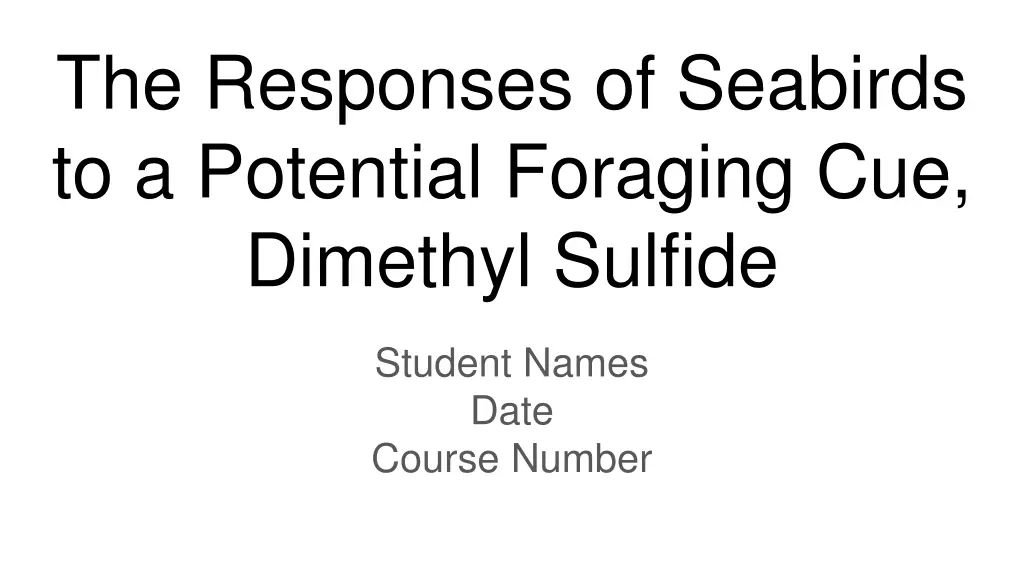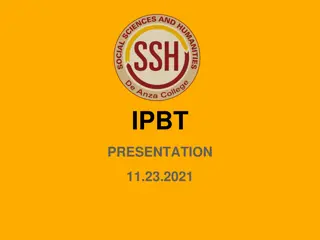
Seabird Foraging Responses to Dimethyl Sulfide
Explore how seabirds respond to Dimethyl Sulfide (DMS) as a foraging cue. Activities involving King penguins and Blue petrels show varied sensitivities to DMS, influencing their foraging behavior. Detailed analysis and results presented.
Download Presentation

Please find below an Image/Link to download the presentation.
The content on the website is provided AS IS for your information and personal use only. It may not be sold, licensed, or shared on other websites without obtaining consent from the author. If you encounter any issues during the download, it is possible that the publisher has removed the file from their server.
You are allowed to download the files provided on this website for personal or commercial use, subject to the condition that they are used lawfully. All files are the property of their respective owners.
The content on the website is provided AS IS for your information and personal use only. It may not be sold, licensed, or shared on other websites without obtaining consent from the author.
E N D
Presentation Transcript
The Responses of Seabirds to a Potential Foraging Cue, Dimethyl Sulfide Student Names Date Course Number
Activity 1: Can King penguin adults and chicks detect DMS? Concluding statement: Adult King penguins can detect DMS, while their chicks cannot. 25 16 Control DMS Control DMS 14 20 Number of birds Number of birds 12 10 15 8 10 6 4 5 2 0 0 0 1 2 0 1 2 Response Response Figure 1. Mean responses of sleeping adult King penguins to DMS and Control presentations. Average response for adult King penguins to the control odor was 0.41 0.085 (SE). Average response for adult King penguins to the DMS odor was 0.76 0.10 (SE). Penguins responded significantly more to the DMS presentation than the control odor (p = 0.0087) Figure 2. Mean responses of sleeping King penguin chicks to DMS and Control presentations. Average response for chick King penguins to the control odor was 0.59 0.13 (SE). Average response for chick King penguins to the DMS odor was 0.62 0.12 (SE). No significant differences in the responses between treatments were observed (p = 0.468)
Activity 2: Are King penguins attracted to DMS? Concluding statement: King penguins recruited more to the lake when the DMS was present, relative to the control. This suggests that the DMS was attractive to the birds. 25 14 y = 0.0027x + 4.2155 R = 0.1034 Number of birds observed y = -0.0016x + 5.9006 R = 0.0659 Number of birds observed 12 20 10 15 8 6 10 4 5 2 0 0 0 500 1000 1500 2000 0 500 1000 1500 2000 Time (seconds) Time (seconds) Figure 4. The number of King penguins swimming in the water following the DMS deployment. There is a significant positive correlation between number of birds visiting the lake and time since odor deployment (R2= 0.0659, p < 0.0001). Figure 3. The number of King penguins swimming in the water following the Control deployment. There is a negative correlation between number of birds visiting the lake and time since odor deployment (R2= 0.1034, p < 0.0001).
Activity 3: Are other seabirds sensitive to DMS? 18 16 Concluding statement: Blue petrels can detect DMS. 14 Number of birds 12 10 8 6 4 2 0 DMS Control Y-maze arm Figure 5. The number of Blue petrels choosing either DMS or Control odor release arms in a Y-maze. The birds chose the arm of the maze associated with DMS significantly more often than the arm with the control odor (p = 0.0046).






















